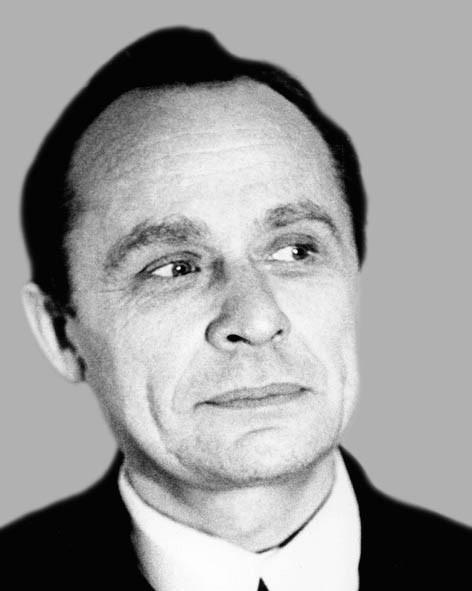Oleksiy Andriyovych Bratko-Kutynsky (born November 26, 1926, in Kyiv—died June 8, 1993, ibid.) was a psychologist, participant in the Ukrainian resistance movement, researcher, and public figure. He was a Candidate of Psychological Sciences (1967).

His father, Andriy Maksymovych Bratko, was an engineer. His mother, Vira Ivanivna Kutynska, was a Boichukist artist and the costume designer for the film “Natalka Poltavka.” His uncle, Mykhailo Ivanovych Kutynsky, was the creator of the unique encyclopedia “Necropolis of Ukraine.”
In 1955, Bratko-Kutynsky graduated from the Faculty of Philosophy at Kyiv University. He worked for a district newspaper in the Kyiv Oblast. From 1957 to 1958, he worked at a television studio, and from 1958 through the 1960s, he was an editor at the Ukrainian Soviet Encyclopedia. In 1960, he began his postgraduate studies at Kyiv University. In 1964, he defended his candidate dissertation on problems of modeling the psyche. Starting in 1964, he was a researcher at the Institute of Psychology of the Academy of Sciences of the Ukrainian SSR, where he met Yevhen Sverstiuk, V. Andriyevska, Vira Tkachenko, V. Romanets, and others. In April 1968, he signed the “Letter of the 139” to the General Secretary of the Central Committee of the CPSU, L. Brezhnev, protesting the arrests of young intellectuals in Ukraine and Moscow. At the Institute, he researched the problems and methods of modeling the psyche, the possibilities of their application in psychology, the construction of models of mental processes, and ways to establish cooperation between psychologists, neurophysiologists, and cyberneticists. In 1972, he was dismissed from his job for refusing to testify against Yevhen Sverstiuk. Bratko-Kutynsky was repeatedly summoned to the KGB. He was under surveillance, and his home phone was tapped. He corresponded with Sverstiuk during his imprisonment and maintained friendly relations with his family and his wife, V. Andriyevska.
After his dismissal from the Institute of Psychology, he struggled to find work for a long time, holding various jobs outside his field. From 1973 to 1974, he worked at the Institute of Information of the Academy of Sciences of the Ukrainian SSR, from where he was also dismissed. He was unemployed again for over a year. From 1975 until the 1980s, he was the head of postgraduate studies at the Institute of Wood Processing of the Ministry of Forestry of Ukraine. He was later transferred to the Center for Scientific and Technical Information within the same ministry. He continued his research independently, moving away from an objective form of cognition and focusing on the theoretical and practical study of the psyche based on a subjective approach. He proposed his own schema for the interaction of the subsystems of human activity, which expanded the human worldview to an understanding of the phenomenon of the psyche.
Bratko-Kutynsky authored numerous articles, short stories, and several monographs. His research covered problems of intelligence, modeling of the psyche, and the history of Ukrainian state and national symbols. He proposed methods for studying the connections between the psyche and the psychic manifestations of the Universe through the prism of the world’s most famous religions and philosophical teachings (Buddhism, Taoism, karate, Zen, yoga, Lamaism, Tantrism, Vedantism, magic, alchemy, Christianity, Judaism, and Islam). In his work “The Phenomenon of Ukraine” (*Vechirniy Kyiv*, 1996), he argued that the ideological worldview of the Ukrainian ethnos, based on the image of triunity (realized, in particular, in the symbol of the trident), corresponds to the highest level of knowledge about the structure of the universe, and that the Ukrainian nation is not only what is, but also what was and what is yet to come.
In 1990, he joined the Ukrainian Republican Party, participated in party conferences, and published thematic articles in its publications on the role of the nation, the state, the relationship between them, and so on. In the last years of his life, Bratko-Kutynsky researched the genesis of Ukrainian state symbolism as something that arises from the historical and cultural development of the people and is closely linked to their spirituality, their striving for unity, and their readiness to fulfill their national tasks and secure their national interests. He highlighted two main principles for structuring the environment in which the Ukrainian ethnos unfolds: the triunity of the cosmos-creating force and the cyclical nature of its manifestation. These theoretical principles of the Ukrainian ethnos were reflected in Bratko-Kutynsky’s monograph, “The Phenomenon of Ukraine,” which was published in 2008, after his death.
He is buried at the Baikove Cemetery in Kyiv.
Bibliography:
- “Psychology and Cybernetics.” In *Models of Mental Activity*. Kyiv, 1968.
- *Modeling the Psyche*. Moscow, 1969.
- *Modeling Mental Activity* (1969).
- *What Guides the Stars? (The Universe and Intelligence)*. Kyiv, 1970.
- *Information and the Psyche*. Novosibirsk, 1977.
- *Descendants of the Holy Trinity*. Kyiv: Bilyi Ptakh, 1992, 85 pp.
- *The Phenomenon of Ukraine*. Kyiv: Vechirniy Kyiv, 1996, 302 pp.
- *How to Improve Your Psyche*. Kyiv: Artek, 2003, 174 pp.
- *The Phenomenon of Ukraine. A Scientific Study*. Kyiv, 2008, 302 pp.